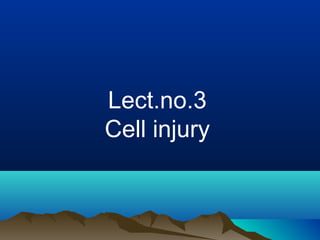
Lect.no.3
- 2. hypertesion C E 1. If the adaptive capacity is exceeded L Prolonged starvation i.e.adaptation is no L longer possible Incomplete occlusion of coronary artery I Complete sudden N 2. if the injury is rapid i.e.No time for adaptation occlusion J U 3. When adaptation is not possible for any reason (neurons) R Y
- 3. When cells encounter physiological stresses or pathological stimuli, they undergo adaptation, achieving a new a steady state and preserving viability. adaptation normal Irreversible Injury (cell death) with severe and persistent stress, irreversible injury results. Reversible Injury If adaptation is exceeded, cell injury occurs. Within certain limits, injury is reversible. If this limit exceeded, injury becomes irreversible leading to cell death.
- 4. Mechanisms of cell injury General principles • 1. The cellular response to injury depends on the type, duration and severity of the injury.
- 5. General principles • 2.The consequences of an injurious stimulus depend on the type, state, adaptability, and genetic makeup of injured cell. • Skeletal muscle accommodates complete ischemia for 2 to 3 hours without irreversible injury. • cardiac muscle dies after 20 to 30 minutes. • Neuron dies after a few minutes.
- 6. Injury starts at subcellular level
- 7. General principles 3. Cell injury results from an abnormality in one or more essential cellular components: four intracellular systems are particularly vulnerable. • Cell membrane integrity, critical to cellular ionic and osmotic homeostasis; • ATP generation, largely via mitochondrial aerobic respiration; • Protein synthesis; • Intergrity of the genetic apparatus.
- 8. Causes of Cell Injury 1. O2 deprivation which impairs aerobic respiration & the ability to produce ATP. This is a common cause of cell death. a. Hypoxia- lack of O2 results in decreased aerobic respiration b. Ischemia- lack of O2 & metabolic substrates 2. Physical agents- mechanical trauma, temperature changes, shock, radiation etc. 3. Chemical agents - acids, bases, toxins, therapeutic drugs, pollutants, etc.
- 9. Causes of Cell Injury 4. Infectious agents 5. Immunologic reactions a. Hypersensetivity reactions b. Immune deficiency. c. Autoimmune reaction 6. Genetic derangements 7. Nutritional imbalances a. Deficiencies b. Excesses
- 10. Mechanisms & Pathogenesis of Cell Injury INJURY cause • Defects in plasma membrane permeability. • ATP depletion • Accumulation of Oxygen-Derived free radical (Oxidative stress) • Loss of calcium homeostasis. • Mitochondrial damage. • Genetic damage
- 11. REVERSIBLE CELL INJURY • It occurs when environmental changes exceed the capacity of the cell to maintain normal hemostasis or adaptation. If the stress is removed in tissue or if the cell withstand the assult the injury is reversible
- 12. ATP depletion <5-10% of normal • ATP use > ATP synthesis is a common consequence of both ischemic & toxic injury. • ATP production occurs via 2 related mechanism Glycolysis – cytosolic, low yield, lactate production (↓pH) Oxidative phosphorylation – mitochondrial, high yield • Hypoxia results in ↑ed glycolysis (depletion of glycogen & ↓pH) • ATP is critical for: Membrane transport Maintenance of ionic gradients ( Na+, K+ Ca2+) Protein synthesis Cytoskeletal function (microfilaments)
- 13. Mechanisms of Cell Injury in ischemia/hypoxia. Depletion of ATP Na+ K+ Ca2+
- 14. Morphology of Reversible Cell Injury Reversible Injury Cellular swelling Fatty change
- 15. Ischemic injury
- 17. Reversible vs irreversible cell injury Reversible injury Irreversible injury * Decreased ATP * Amorphous levels densities in mitochondria * Ion imbalance * Severe membrane * Swelling damage Decreased pH * Lysosomal rupture Inflammation in surrounding tissues
- 18. General principle • Cellular function is far before cell death occurs, and the morphologic changes of cell injury(or death) lag far behind both. • REVERSIBLE Loss of function • IRREVERSIBLE • DEATH • EM • LIGHT MICROSCOPY • GROSS APPEARANCES
- 19. Timing of biochemical & morphologic changes in cell injury
- 23. FREE RADICALS • Molecular species with a single unpaired electron available in an outer orbital shell. Single free radicals initiate chain reactions which destroy large numbers of organic molecules
- 24. • The most important free radicals are probably those derived from oxygen, i.e., superoxide (O.-2) and hydroxyl radical (OH.); hydrogen peroxide, though not a free radical, is two hydroxyl radicals joined.
- 26. • Free radicals may be generated in the following ways: • 1. By absorbing radiant energy (UV, x-rays; striking water, these generate a hydrogen atom and a hydroxyl radical. • 2. As part of normal metabolism (for example, xanthine oxidase and the P450 systems generate superoxide; our white cells use free radicals to attack and kill invaders) • 3. As part of the metabolism of drugs and poisons (the most famous being CCl3.-, from carbon tetrachloride; even O2 in high concentrations generates enough free radicals to gravely injure the lungs).
- 27. Free Radicals Free Radical Defense 1. Spontaneous decay 2. Antioxidants (enzymatic & non- enzymatic) 3. Free radical scavenging systems
- 28. FREE-RADICAL EFFECTS • 1. Oxidation of unsaturated fatty acids in membranes ("lipid peroxidation", etc.). • 2. Cross-linking of sulfhydryl groups of proteins.( protein denaturation) • 3.Genetic mutations (DNA depolymerization)
Editor's Notes
- In light microscopy inability to recognize nuclei because they broke up (karyorhexis, karyolysis) is a common criterion of cell death.
